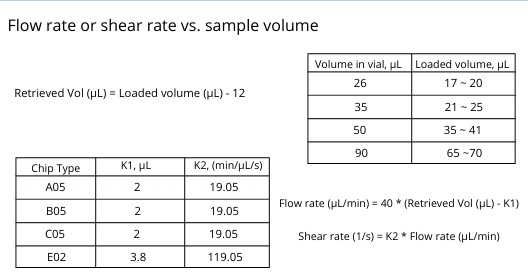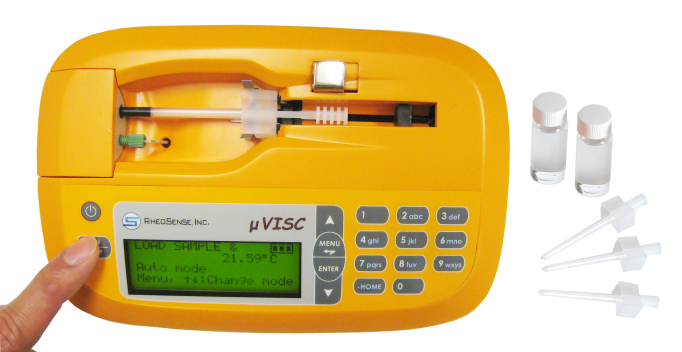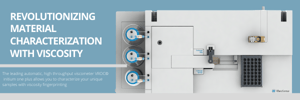The RheoSense VROC® initium one plus automated viscometer is revolutionizing material characterization with just the push of a button. The research and development that has gone into this automated viscometer has led to the design of a solution that provides full sample characterization with minimal volume and minimal labor, and an intuitive software that provides automatic testing of samples. This design is catered to what matters most to our customers: increased productivity, decreased time to market, and increased return on investment (ROI).
When working with the VROC initium one plus there are several standard, or pre-loaded, protocols designed to keep your instrument running optimally and produce the most accurate data possible. Our team has created standard loading, measurement and cleaning protocols for the VROC initium one plus.
Loading protocols
The VROC initium one plus includes an intuitive software that allows automatic testing of samples on 96 well plate or a 40 vial rack runs. You are able to run viscosity measurements on sample sizes as small as 26µL. Standard loading protocols tied to chip type and standard cleaning protocols are included in the VROC initium one plus software. These protocols are created for sample volumes of 26µL, 35µL, 50µL, and 90µL.
 Learn more about VROC flow rate vs. sample volume recommendations
Learn more about VROC flow rate vs. sample volume recommendations
Measurement protocols
Measurements protocols are created based primarily around 5 different sample measurement parameters:
- Shear/ flow rate
- Number of data points to measure
- Sample volume
- Temperature
- Approximate sample viscosity
Understanding the approximate viscosity of the sample you are testing is imperative for determining appropriate testing parameters and ensuring data quality. If the viscosity of your sample is unknown the VROC initium one plus includes and "auto" run that will help users to establish a baseline for their sample. When the auto feature is selected all measurement parameters are set to 0. The software will run the sample at ~50% of the selected VROC® chip maximum pressure range (max kPa). The testing temperature must still be set by the end user (standard testing is typically done at 25°C) and measurement volume is automatically set to 26µL(the minimum amount the autosampler will load into the test syringe).
Our intuitive software will determine wait, measurement, and pause times based on the shear rate set, or can be manually set by the user.

Sample volume considerations when setting up measurement protocols include: the number of data points you are trying to collect (more volume is needed when you are measuring more data points), flow rate , (high flow rates will require more volume for testing), time, sample retrieval, and sample recovery. Retrieval allows for unlimited testing on the same sample while recovery provides the ability to do orthogonal testing on a sample with known history. The software features an estimated sample volume requirement functionality, which determines the minimal amount of sample needed to run your samples based on the number of data points, flow rate, and sample retrieval and recovery entered by the user. This feature will not allow measurements to run if there is less volume being loaded than what is required to ensure quality of your data.
Cleaning protocols
Standard cleaning protocols are based on the type of VROC chip being used and are determined by a combination of a logistical set of steps for what is upstream and downstream in the system when running a sample. The VROC initium one plus software cleans based on the order of flow path of the measured sample. This ensures that every flow path the sample passed through is thoroughly cleaned. The development of these protocols also takes into consideration soak time for the VROC chips, depending on viscosity of sample measured, and solvent flow rate, providing more thorough chip cleaning.
While the cleaning protocol paths may be consistent, the solvents used for cleaning can be changed based on compatibility with the sample that was tested. Cleaning protocols for the VROC initium one plus include 3 different solvents:
- Primary (Buffer) - Commonly used when measuring protein samples. This is the best way to clean out VROC chips without causing unwanted chemical reactions, however when buffers dry they leave behind a salt residue
- Secondary (Aquet) - A surfactant that will clean out salt residues formed in the chip flow path during the buffer cleaning step
- Enhancer (IPA/ heptane/acetone) - A nonvolatile solution that gets off all the residue accumulated in the surfactant step, and also has the benefit of drying out quickly to help reduce drying time of VROC chips
Solvents are recommended based on what will dissolve with solutions. The standard, or generic, solvents we recommend are compatible with ~80% of generic solutions. For example, when working with protein or antibody samples you typically use a buffer for the sample and then flush your chip out with that compatible buffer (such as PBS), or when working with polymer solutions you will typically have them in an organic solvent. Using a solvent that is not compatible with your sample can lead to clogging of the chip flow channel. For example, if you are testing proteins, IPA is typically not a compatible solvent.
Users are able to adjust flow rate of cleaning solvents to prevent tunneling (when working with high viscosity samples, low viscosity cleaning solvents can leave sample along the walls of your chips creating a "tunnel") in the chip flow channels.
Learn more about VROC chip cleaning and maintenance best practices.
Written by: Eden Reid, RheoSense Senior Marketing and Sales Operations & Sid Kolhatkar, RheoSense Engineer I


